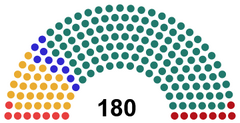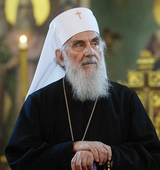Radushia: Difference between revisions
| Line 162: | Line 162: | ||
=== Climate === | === Climate === | ||
Due to Radushia's geographical position in central western Euclea and its distance from open sea, the country has a climate that is continental and temperate, with the four seasons taking distinct forms. The annual temperature on average is 13 °C (55 °F) in the south around Lake Min and 9 °C (48 °F) in the north. During summer, average temperatures at their height in [[Chrivotava]] rise to 29 °C (84 °F), and temperatures surpassing 35 °C (95 °F) are common in low-lying areas of the country, especially those of the [[Ščodraja Raŭnina]]. The coast of Lake Min during summer sees the most limited range in temperature changes and enjoys limited humidity, providing it a comfortable warm summer each year. During winter, the average temperature is below 3 °C (37 °F), with minimum temperatures of -1 °C (30 °F) being recorded in low-lying areas. Precipitation is average, with over 780 mm (30.7 in) per year in the north and west, around the [[Navahrudak foothills]], while around Chrivotava it drops to approximately 670 mm (26 in). | |||
=== Fauna and flora === | === Fauna and flora === | ||
Revision as of 18:57, 7 September 2020
Sotirian Republic of Radushia Сацірскі Радауская Чува́шская Sacirski Radauskaja Respublika | |
|---|---|
Motto:
| |
Anthem:
| |
| Capital and largest city | Chrivotava |
| Official languages | Belonarodyn |
| Recognised national languages | Narodyn |
| Religion | Episemalist Sotirianity 90.2% Irreligious 6.4% Other 3.4% |
| Demonym(s) | Radushian |
| Government | Unitary dominant party theocratic parliamentary republic |
| Macarius II | |
| Ramon Yarmoshyn | |
| Legislature | Viarchoŭny Rada |
| Independence from Narozalica | |
• Declaration of Independence | 3 August 1979 |
• Treaty of Boltovo | 23 August 1979 |
• Saint George's Day Revolution | 6 May 1982 |
• Sotirian Republic established | 1 June 1982 |
• Current constitution | 6 May 1999 |
| Area | |
• | 8,646 km2 (3,338 sq mi) |
• Water (%) | 3.5% |
| Population | |
• 2020 estimate | |
• 2016 census | 4,102,147 |
• Density | 485.04/km2 (1,256.2/sq mi) |
| GDP (PPP) | 2019 estimate |
• Total | |
• Per capita | |
| GDP (nominal) | 2019 estimate |
• Total | $41.92 billion (36th) |
• Per capita | |
| Gini | 29.9 low |
| HDI | high |
| Currency | Radushian Zolota (RUZ) |
| Driving side | right |
| Internet TLD | .rd |
Radushia (Чува́шская; Radushiya), officially the Sotirian Republic of Radushia (Сацірскі Радауская Чува́уская; Sacirski Respublika Radushiya) is a landlocked country located in western Euclea, bordering Poliania to the west, Narozalica to the north, XX to the east and Lake XXX to the south. A small nation, it has a total area of 4,646 km² (3,338 sq mi) and a population of 4.91 million. It's capital is Detkovo and its largest city is Boltovo.
History...
History...
Today, Radushia is a member of the Community of Nations, ITO and the GIFA. Radushia is also a member of Samorspi. Despite it's size, Radushia holds significant cultural and religious influence, especially among nations of the Epistmalist Catholic Church. Radushia's economic growth and development has improved in recent years, with continued rise in living standards and incomes.
History
Pre-history
Ancient
Principality of Radushia (1085-1466)
Kingdom of Radushia (1466-1721)
Narozalic Empire (1721-1861)
Narozalic Republic (1861-1981)
Path to independence
Political crisis (1980-82)
Modern (1984-present)
Geography
Radushia is a landlocked country located in Western Euclea. It is bordered to the north by Narozalica, Vedmed to the east, Lake Min to the south and XX to the west. The country has a total area of 8,646 km2 (3,338 sq mi), making it one of the smallest countries in Euclea and the world. Radushia's geography is defined by the Dolomit River, which disects the country in half from north-to-south, where it deposits into Lake Min. The entire country also resets within the Dolomit's drainage basin. Surrounding the delta of Lake Min is the Ščodraja Raŭnina (Щчодрасці Pаўніна; lit. the Generous Plain), an area of rich fertile soil and dominated by flat plains and farmland. The Ščodraja Raŭnina covers the entirety of Radushia's shoreline with Lake Min and runs northward toward the Navahrudak foothills, which ultimately settle into the Radushian plateau. To the west of Radushia is the XX Mountains, which raise the elevation of the country's most westward regions. Northern Radushia besides the Dolomit River valley is dominated by forested regions and rolling hills. Historically, Radushia was covered by forest to a degree of 75%, yet human development and industrialisation has since reduced this number to 30% of total land area.
Radushia hosts 8 national parks, 35 landscape protection area and 77 minor nature reserves. Since 1990, the numbers of such areas has declined, with the Slonim-Mihai National Park having been closed down in 2009 and de-registered to enable economic development.
Climate
Due to Radushia's geographical position in central western Euclea and its distance from open sea, the country has a climate that is continental and temperate, with the four seasons taking distinct forms. The annual temperature on average is 13 °C (55 °F) in the south around Lake Min and 9 °C (48 °F) in the north. During summer, average temperatures at their height in Chrivotava rise to 29 °C (84 °F), and temperatures surpassing 35 °C (95 °F) are common in low-lying areas of the country, especially those of the Ščodraja Raŭnina. The coast of Lake Min during summer sees the most limited range in temperature changes and enjoys limited humidity, providing it a comfortable warm summer each year. During winter, the average temperature is below 3 °C (37 °F), with minimum temperatures of -1 °C (30 °F) being recorded in low-lying areas. Precipitation is average, with over 780 mm (30.7 in) per year in the north and west, around the Navahrudak foothills, while around Chrivotava it drops to approximately 670 mm (26 in).
Fauna and flora
Government and politics
 |
|
Government (126) All-Radushian Sotirian Party (126) Opposition (54) Civic National Party (28) Sotirian Party of the Regions (10) Workers' Dignity (8) Party of the Radushian Motherland (8) |
The government and political system of Radushia is defined by the 1982 constitution adopted in wake of the Saint George's Day Revolution. Officially, Radushia is a unitary parliamentary republic with a fusion of theocratic elements and is a multi-party democracy. However, in reality, many observers consider Radushia to be a hybrid regime under a dominant party supported by an authoritarian theocratic framework.
The head of state of Radushia is the Supreme Patriarch, who holds the office for life and concurrently to serving as the Patriarch of the Radushian Episemalist Church and Metropolitan of Chrivotava. The office of the Supreme Patriarch is embued with several executive perogatives and powers, including the right to appoint and dismiss Minister-Presidents, any cabinet minister or the government in entirety, dissolving the Viarchoŭny Rada and appointing and dismissing the heads of the armed forces, security services and state broadcasters. The Supreme Patriarch's spiritual influence also plays a significant role in temporal matters and can alter the fortunes of both government and legislation alone. The current Supreme Patriarch is Macarius II, who was elevated to the Patriarchate in 2014.
The position of Minister-President, Radushia's head of government, belongs to the individual most likely to command the confidence of the Viarchoŭny Rada; this individual is typically the leader of the political party or coalition of parties that holds the largest number of seats. By convention, the Supreme Patriarch would appoint that person to serve as head of government, however, the Supreme Patriarch is entitled to appoint anyone he believes would serve the interests of the nation. On three occassions, the Supreme Patriarch has selected another beside the party or coalition leader. The Minister-President chairs the Council of Ministers, whose appointment is dependent upon the confidence of the Supreme Patriarch. The current Minister-President is Ramon Yarmoshyn who has served since 2014.
The legislature of Radushia is the unicameral Viarchoŭny Rada, comprising of 180 seats. All members of the government, including the Minister-President must be a serving member of parliament in order to serve, as a result, the Radushian government is accountable to the Rada. For elections to the Viarchoŭny Rada, its 180 representatives are elected by parallel voting, with 90 seats elected by first-past-the-post and 90 elected through proportional representation, with a national threshold of 6%. Officially, elections are held every give years, however, the Supreme Patriarch is entitled to dissolve the Viarchoŭny Rada at his pleasure, he may also dissolve the Rada at the request of the Minister-President. Since the Saint George's Day Revolution in 1982, the All-Radushian Sotirian Party has been the dominant party having serve in government uninterrupted since. Besides the All-Radushian Sotirian Party, there is the Civic National Party, Party of the Radushian Motherland, Workers' Dignity and the Sotirian Party of the Regions.
Supreme Patriarch
Role of the Radushian Epistmalist Church
Administrative divisions
Foreign relations
Armed Forces
Law
Economy
Demographics
| Historical population | ||
|---|---|---|
| Year | Pop. | ±% |
| 1956 | 2,974,122 | — |
| 1966 | 3,535,140 | +18.9% |
| 1976 | 4,416,898 | +24.9% |
| 1986 | 4,400,024 | −0.4% |
| 1996 | 4,225,871 | −4.0% |
| 2006 | 4,008,715 | −5.1% |
| 2016 | 4,193,694 | +4.6% |
| Source: Narozalic Census (1956-1976) Radushian State Census (1986-) | ||
Ethnic groups
Language
Religion

Healthcare
Education

Education in Radushia is split roughly equally between state-run and church-run institutions. Church schools tend to be of higher quality in teaching, learning content and are widely seen as more prestigious than state-run institutions. However, criticisms exist in that Church-shcools operate beyond government oversight and have little accountability. Anti-government critics have argued that church schools in Radushia are designed to "entrench support for the theocratic system, over preparing students for careers."
Urbanisation
Chirvotava, the nation's capital and largest city, was home to 1,117,900 residents in 2018, representing 26.65% of the national population. Ottseda, with a population of 181,000, is the second-largest city and is located on the shores of Lake XXX. Other large cities are Svaryn (165,100), Sviaty Michal (118,400), Sviaty Mikola (89,800) and Aleksandrina (78,300).
Largest cities or towns in Radushia
NBS (2019) | |||||||||
|---|---|---|---|---|---|---|---|---|---|
| Rank | County | Pop. | |||||||
 Chrivotava  Ottseda |
1 | Chrivotava | Chrivotava | 1,117,900 |  Svaryn  Sviaty Michal | ||||
| 2 | Ottseda | Sviokrava | 181,024 | ||||||
| 3 | Svaryn | Kvatory | 165,137 | ||||||
| 4 | Sviaty Michal | Sviaty Michal | 118,444 | ||||||
| 5 | Sviaty Mikola | Sviaty Mikola | 89,800 | ||||||
| 6 | Aleksandrina | Vidamlya | 78,365 | ||||||
| 7 | Harbacha | Harbacha | 61,364 | ||||||
| 8 | Solomyn | Solomyn | 51,701 | ||||||
| 9 | Novaya Antonovka | Sviaty Paviel | 50,988 | ||||||
| 10 | Staraya Vodva | Sviaty Džordž | 47,532 | ||||||








